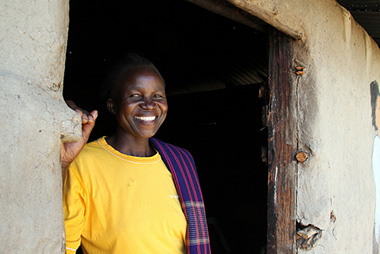The following story was originally published on the CGIAR Research Program on Agriculture for Nutrition and Health (A4NH) website.
Many of the foods people depend on most for their sustenance, especially in low and middle income countries, can carry a silent killer: aflatoxins. These naturally occurring fungal toxins contaminate food crops, such as maize, groundnuts, tree nuts, and a range of other produce, and unfortunately, are not always easily detectable. The health effects of aflatoxin exposure can be cumulative, leading to liver disease and even death. Recently, some studies have suggested that exposure to aflatoxin also may impede child growth, potentially contributing to a significant problem of unexplained stunting in many poor countries.
In recent years, international donors have invested heavily in aflatoxin control in poor countries, partly based on a small number of studies linking aflatoxin consumption to child stunting. Although the findings of these studies are consistent, none adequately control for factors that could potentially confound the association between aflatoxin and child growth—such as poverty. Children in poorer households are more likely to be fed diets deficient in essential nutrients. They also are likely to suffer from more frequent infections, another common cause of child stunting. Are increased rates of child stunting among poor households a result of higher levels of aflatoxin exposure or more likely due to poor diet quality and increased exposure to infection? Unfortunately, very little is known about the role of poverty in aflatoxin exposure.
A new study funded by the UK Government’s Department for International Development (DFID) and A4NH conducted by researchers at IFPRI and the University of Georgia addresses this question. Leroy, Wang, and Jones studied aflatoxin exposure in nearly 900 women of childbearing age in rural Kenya. Socioeconomic status was measured using a comprehensive household questionnaire. Aflatoxin exposure was assessed by determining women’s serum aflatoxin levels.
Aflatoxin was detected in the serum of all surveyed women. Most surprisingly, even among this fairly homogenous group of women from poor rural households in Kenya’s Eastern Province, there were significant differences based on poverty levels. The study found that serum aflatoxin levels were 5 to 7 times higher among the poorest women, as compared to the least poor. The poverty effect was large: a recent post-harvest intervention designed to reduce aflatoxin in Guinea documented an effect half of the size of that which was found in this study.
“In this study, we found that household expenditure, food security, land ownership, and education levels were all strongly associated with women’s exposure to aflatoxin”, says IFPRI’s Kelly Jones. How exactly these socio-economic factors influence aflatoxin exposure will require additional research, adds IFPRI senior researcher Jef Leroy. “Crops grown by poorer farmers might be more prone to stress in the field, and might not be harvested, dried and stored adequately, all of which can increase aflatoxin contamination. Another pathway is the consumption of contaminated purchased foods. Recent evidence from Kenya shows that the cheaper commercial maize brands had the highest contamination levels.”
Whether or not aflatoxin truly causes child stunting is a question that can only be answered through a rigorous approach, such as a randomized-controlled trial. An ongoing trial by IFPRI will make headway toward answering that question. In the meantime, the finding that the poorest families are at the greatest health risk from this food-borne toxin suggests that addressing aflatoxin contamination should be a priority for policymakers concerned about the welfare of the poor.
*To request a copy of this article, please contact: ifpri-library@cgiar.org.







